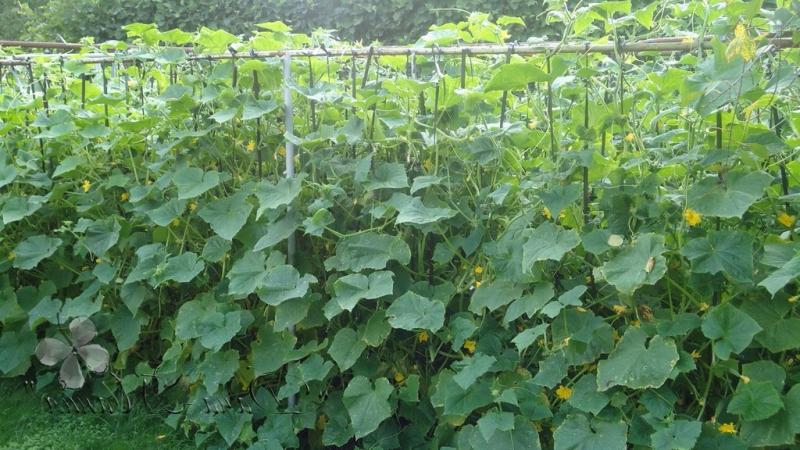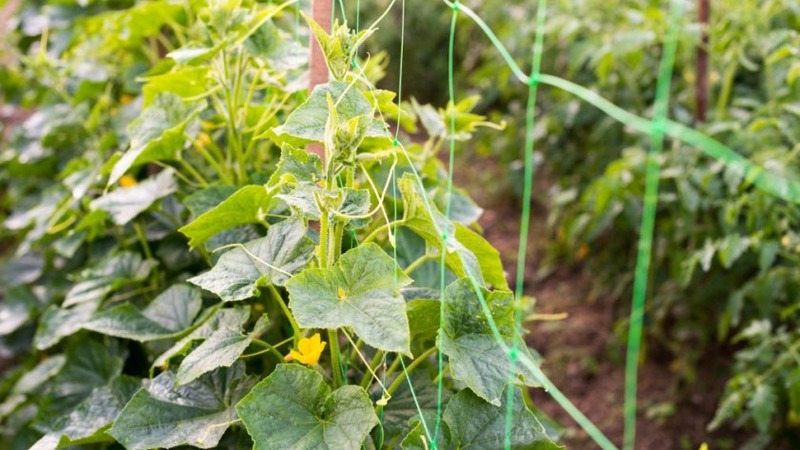At what night temperature do cucumbers grow in the open field and in the greenhouse?
Almost every summer resident has cucumbers in the garden. Despite being a popular vegetable, growing it is not as easy as it might seem. This is especially true of the temperature regime, which is extremely important for the full development of cucumbers.
The content of the article
- At what temperature do cucumbers grow in open ground at night
- Optimum temperature for nighttime growth of cucumbers
- Minimum and maximum allowable temperature
- What to do if the temperature is below normal
- Temperature regime for the growth of cucumbers in the greenhouse
- Tips and tricks from experienced gardeners
- Conclusion
At what temperature do cucumbers grow in open ground at night
Why at night? Because it is at this time of day that the fruits receive nutrients from the leaves. In the open field at high temperatures, fruits will grow more actively, and at moderate temperatures, the shoots and roots of the plant.
The best option here is the golden mean. The temperature during the day and at night should not differ by more than 7 ° C.

Optimum temperature for nighttime growth of cucumbers
Seeds germinate at + 10-12 ° C, and the leaves and the fruits themselves are formed at + 15-16 ° C. If you decide to increase the temperature during seed germination to + 25 ° C, then the process will go much faster, and the sprouts will appear 5-6 days after sowing. If you increase it to + 17-20 ° C, wait for seedlings on the tenth day. Watch the temperature drop carefully, if it falls below + 10 ° C, the sprouts will turn yellow and die.
As for the soil temperature, a lot depends on the type of cucumber. Each has its own optimum germination temperature. The average favorable soil temperature at night is + 16-18 ° C. But the seeds will germinate faster if the air temperature is slightly lower than the soil temperature.
Minimum and maximum allowable temperature
The maximum permissible temperature for cucumbers is + 42 ° C. Already at + 35 ° C, fruiting problems begin. The ovaries dry up and fall off, a spider mite appears, and the pollen becomes sterile. The high temperature contributes to the aging of the lashes, as the root system reduces its absorption capacity.
So that the cucumbers did not die in the abnormal heat, it is necessary to additionally irrigate not only the beds themselves, but also the areas adjacent to them. Sprinkler irrigation contributes to less surface overheating of plants and additionally cools the soil. If possible, cover the trellises with light light agrofibre.
Also, summer residents are worried about hypothermia of plantings. Most often this happens if there is a north wind in the region. The difficulty of open ground is that it is problematic to achieve constant heat, however, gardeners use some tricks that help maintain comfortable conditions:
- Cucumbers are planted along the walls of buildings on the leeward side, but where the sun's rays fall.
- Cucumber trellis are placed between the rows of plants with high stems. Thanks to the "walls", the temperature rises by several degrees and creates additional shade, but in the south this method is not popular, as it can lead to overheating of cucumbers.
Important! Backstage plants in most cases take away some of the moisture, so watering cucumbers in such a neighborhood should be taken with special responsibility.
As for the minimum temperature, at values below + 10 ° C, the root system ceases to absorb nutrients from the soil. As a result, the plants begin to starve and undergo various diseases.If the low temperature (below + 3 ... + 4 ° C) persists for three days, plant tissues begin to deteriorate, as a result, the cucumbers die. If seeds are sown in frozen soil, they will not sprout until it warms up well. Active growth stops at temperatures below + 15 ° C.
The night temperature regime for growing cucumbers should be without sudden changes, as this will lead to a decrease in yield. If temperature fluctuations in your area are sharp, and the night is below favorable for cucumbers, grow them in a greenhouse or greenhouse.
What to do if the temperature is below normal
There are several ways you can help save your cucumbers from prolonged frost. The most common way is to build a warm or dung bed.
Manure ridge

At low temperatures, it will provide the plant with warmth and the necessary nutrients for growth. Do it carefully, as the active combustion phase can be bad for young plants.
A ridge of manure is equipped 14 days before sowing seeds. To do this, place the manure in a tall bed and spill it. Polyethylene will speed up the burning process.
Steam from the ridge means it is working. After two days of active combustion, you can start planting seeds in the holes with the ground. Pay attention to the thickness of the soil. It should be at least 30 cm. If there is a threat of frost, use a film or spunbond (covering material). Cucumber lashes, which grew on manure, are less likely to suffer from diseases.
Warm ridge
This is almost the same as manure, but here they serve as biofuels:
- food waste;
- leaves;
- branches;
- grass;
- tops
Note! If the seedlings are placed on an inorganic pillow and covered with a film on top, then frosts will not be terrible for her. This is also suitable for a rainy summer, as the organic matter is very hot and gives off heat for the growth of cucumbers.
Pros of warm ridges:
- arches and shelters are easy to fix;
- the process of heating the soil is faster, and the seeds can be sown earlier
- weed becomes less;
- drainage in the form of large branches will relieve water stagnation, which is good for the development of the root system;
- organic matter begins to grind and warm up the soil, thanks to which cucumbers grow better at night.
Arcs and covering material
Inexpensive sets for summer residents with plastic arches and covering material will help to save cucumber lashes.
Attention! Installing arcs under the holes will protect the cucumbers from frost in May. A dense covering material will also help seedlings. with the onset of cold weather.
It is recommended to purchase a white spunbond to protect cucumbers from the spring cold snaps. It is better to choose a density of 23 g / m². This is enough to protect the cucumbers from the cold, as well as help them withstand strong winds.
If the frosts have managed to damage the leaves of the cucumbers, use the preparation "Epin". It will help when:
- the cucumbers are frozen;
- leaves turned yellow;
- it rains every day and there is a cold snap;
- attacked by aphids or other pests.
Even with a single treatment with "Epin", the plant's immunity will be restored. Fertilizers cannot be used for two weeks. It is also worth purchasing a growth stimulant.
You can restore cucumber lashes using other good means:
- "Zircon";
- "Narcissa";
- "Amulet";
- Silka.
Fertilizers

Long low temperatures in summer adversely affect cucumbers. Leaves at the tips begin to brighten, the ovaries form more slowly. In this case, they are fed with a solution of urea or urea.
Prepare this solution just before use. 1 tbsp. l. the drug is added to 10 liters of settled water. Dry and cloudy weather is suitable for processing cucumbers.
reference! It will take several times to save cucumbers with this method at intervals of 3 days until the leaves turn dark green.
Folk ways
If the cold weather came unexpectedly, and there was no covering material at hand and there is no time to make a shelter, folk methods will come to the rescue.You can pick the grass or branches and put them on top of the young cucumbers, and lower the ones tied to the trellis a little lower. A layer of mulch will protect against freezing. In the morning, you can shake it off a little, but you should not remove it, as it will be needed so that moisture remains in the soil and it does not freeze.
Another option is to make shelters from roofing material. They are removed in the morning, but at night it is a good protection against frost.
Boric acid is also used as a rescue from low temperatures. A five-gram sachet of powder is stirred in hot water and poured into 10 liters of water. When the sun goes down, the cucumbers are sprayed with this liquid.
Such processing will not only save the cucumbers from freezing, but also make them more resistant to diseases: bacteriosis, powdery mildew, root rot.
Temperature regime for the growth of cucumbers in the greenhouse

It is extremely important to maintain the temperature in the greenhouse - this affects the development and growth of cucumbers, the quantity and quality of nutrients consumed.
Seedlings are planted at temperatures from +20 to + 22 ° C. It is also optimal for the further cultivation of cucumbers in the greenhouse.
If we talk about the temperature of the earth, then in the greenhouse it should not be higher than + 18 ° C and not lower than + 16 ° C. To do this, you need to additionally cover the greenhouse at night.
When 7 days have passed after germination, the temperature should be kept at around + 20 ° C. For more comfortable conditions, make a small access of air outside. But you can't shoot the film at all. This can be bad for the seedlings.
After the appearance of 2-3 leaves, the greenhouse needs to be constantly provided with heat. The optimum temperature for this is + 22-24 ° C.
Attention! Temperature changes should be gradual, otherwise it will have a bad effect on young cucumbers.
Tips and tricks from experienced gardeners
And finally, a few tips from experienced summer residents who know a lot about growing cucumbers:
- Choose varieties that are least susceptible to disease.
- After the first planting, the next seeds are planted after 4-5 weeks. This is necessary so that you can enjoy the harvest in late August or early autumn.
- Always make sure that the soil of the cucumbers is slightly moist. This will protect them from the bitter taste.
- To prevent insects from attacking your crop, cover the plants with translucent material until they bloom and bear fruit.
- When the cucumbers are ripe, harvest every few days. Make sure that the fruits do not turn yellow, as this takes away strength for further fruiting.
Conclusion
If you want to grow cucumbers in your garden, carefully study all aspects of planting. Remember that this culture does not tolerate sudden changes in temperature, abnormal heat and prolonged frost.
There are many ways to protect cucumbers from adverse conditions. Use sprinkler irrigation or light agrofibre during drought, and cover material in case of frost. Then you can get a good harvest, and there will be no problems with growing cucumbers.